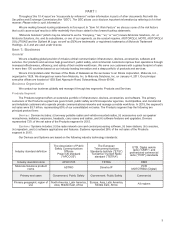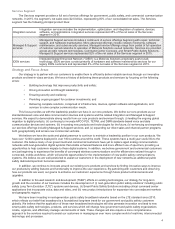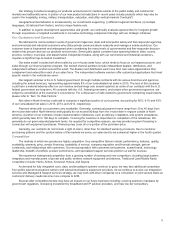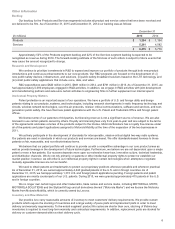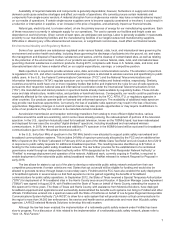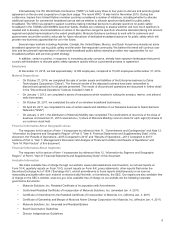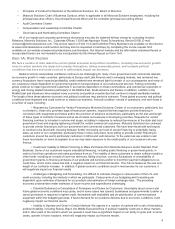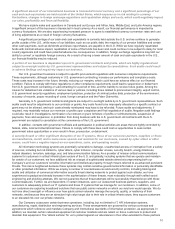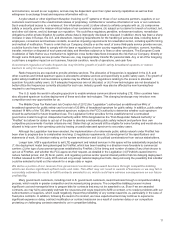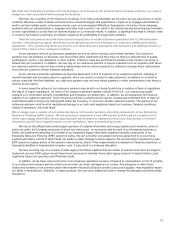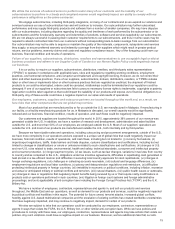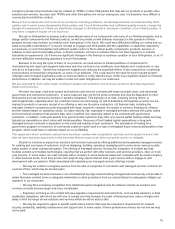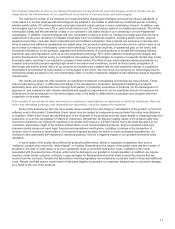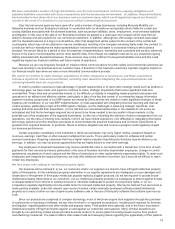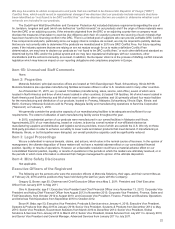Motorola 2015 Annual Report Download - page 14
Download and view the complete annual report
Please find page 14 of the 2015 Motorola annual report below. You can navigate through the pages in the report by either clicking on the pages listed below, or by using the keyword search tool below to find specific information within the annual report.13
Our future operating results depend on our ability to purchase at acceptable prices a sufficient amount of materials,
parts, and components, as well as services and software to meet the demands of our customers and any disruption to
our suppliers or significant increase in the price of supplies could have a negative impact on our results of operations.
Our ability to meet customers' demands depends, in part, on our ability to timely obtain an adequate delivery of quality
materials, parts, and components, as well as services and software from our suppliers. In addition, certain supplies, including for
some of our critical components, are available only from a single source or limited sources and we may not be able to diversify
sources in a timely manner. If demand for our products or services increases from our current expectations or if suppliers are
unable to meet our demand for other reasons, including as a result of natural disasters or financial issues, we could experience
an interruption in supplies or a significant increase in the price of supplies, including as a result of having to move to an
alternative source, that could have a negative impact on our business as a result of increased cost or delay in or inability to
deliver our products. This risk may increase as a result of consolidation of certain of our suppliers. We have experienced
shortages in the past that have negatively impacted our results of operations and may experience such shortages in the future.
In addition, credit constraints at our suppliers could cause us to accelerate payment of accounts payable by us, impacting our
cash flow.
We have seen and expect to continue to see increases in the price of certain supplies as we no longer qualify for certain
volume discounts given our significant decrease in direct material spend over the last several years as a result of our spin-offs
and divestitures. We have also experienced less support and focus from our suppliers as our spend has diminished, making it
more difficult for us to resolve gaps in supply due to unforeseen changes in forecast and demand. In addition, our current
contractual arrangements with certain suppliers may be cancelled or not extended by such suppliers and, therefore, not afford us
with sufficient protection against a reduction or interruption in supplies. Moreover, in the event any of these suppliers breach their
contracts with us, our legal remedies associated with such a breach may be insufficient to compensate us for any damages we
may suffer.
Our sales within a quarter are not linear, with a substantial percentage of products shipping in the final month of the
quarter. This lack of linearity creates inefficiencies in our business performance and any interruption during this final
month could have a substantial impact on our quarterly financial results.
On average, a substantial percentage of our quarterly sales ship in the final month of a quarter. Any interruption in our
ability to ship products during this final month, such as unavailability of critical components, disruption to our manufacturing
capabilities or disruptions in our distribution channel, will have a disproportionately large impact on our quarterly financial results,
as we may be unable to recover in time to ship the products and recognize revenue in that quarter.
In addition, this lack of linearity results in inefficiencies in our financial performance, as we must invest in capacity and
resources to support this business model, meaning we have underutilized operations during the first two months of the
quarter. We also must maintain additional component inventory and engage in pre-builds of finished goods to mitigate the impact
of this lack of linearity and meet potential last month demand. This could result in our carrying excess inventory, which is costly
and may result in increased inventory obsolescence over time.


